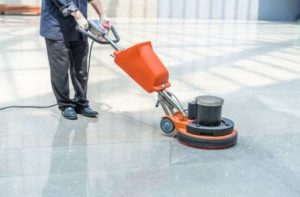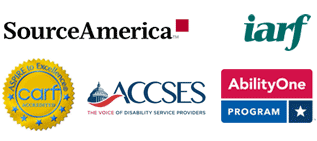The Pathway to Meaningful Work for All Abilities Starts Here!
5 Costly Floor Care Mistakes and How to Avoid Them
written by Chris Kuhn
 Floor care is complicated, and when you add factors like snow, ice, and salt to the equation, finding the right floor care solution can seem nearly impossible. Businesses commonly make the same floor care mistakes over and over, and these mistakes can cost your business a lot of time, money, and labor to fix. Below we highlight some of the most common commercial floor mistakes and how they can be avoided.
Floor care is complicated, and when you add factors like snow, ice, and salt to the equation, finding the right floor care solution can seem nearly impossible. Businesses commonly make the same floor care mistakes over and over, and these mistakes can cost your business a lot of time, money, and labor to fix. Below we highlight some of the most common commercial floor mistakes and how they can be avoided.
Mistake # 1 Eliminating the normal floor care maintenance because of budget constraints.
Floors get an abundance of foot traffic (in all kinds of weather) and inadvertent damage from objects being dropped on and dragged or pushed across them. Properly maintaining the floor of your commercial building requires more care and attention than a quick mopping with soapy water or vacuuming whenever the floor looks dirty. A floor that is properly maintained and clean fosters a professional image for your place of business. That image goes a long way in attracting new clients and maintaining old ones. Additionally, properly cleaning your flooring also reduces the risk of accidents. Slips, trips and fall injuries make up almost 20% of all job-related injuries. Unsuitable maintenance can slash the life of your floors by as much as half. We understand the drive to cut costs can be strong, but even if your floors do not look dirty, they are. The main two issues with failing to regularly clean carpets and finish hard surfaces regularly are these. First, flooring manufacturers has set a regular cleaning schedule you must meet to have the full protection of your warranty. This is often yearly or twice yearly. Second, even if the floor does not look too bad, the dirt, grit and grime allowed to accumulate is ground into the floors surface and will remain even with vacuuming and mopping. Causing wear and dulling that is bad for the floor’s overall appearance and usable lifespan. Lastly, not regularly cleaning your floors means that small problems can grow over time, and present bigger and more costly cleaning challenges later.
Mistake #2 Service providers that lacks transparency in their pricing.
Choosing a service provider that lacks clear pricing will put you behind the eight ball every time. Not only should you know precisely what you are buying and what it will cost, you deserve the opportunity to ask questions, check references, to be sure you are receiving the best value for your facility. A service provider that is looking for a long-term partnership is happy to provide you with clear pricing and references to compare your options. A true partner will take the time to understand your budget and pricing constraints and provide value added solutions to work through these issues. It is also wise to ask the service provider if they have achieved professional certifications like the ISSA’s CIMS as they have been scrutinized and assessed as to whether or not they work to industry best standards.
Mistake #3 Enlisting a cleaning company that uses the wrong equipment or poorly maintained equipment.
Floor care equipment takes a beating and must be frequently checked, serviced, and even replaced. If your service provider is trying to cut corners with equipment service or replacement, it may be saving THEM money, but it can cost YOU. Poorly maintained or dated equipment is abusive to both soft and hard surface floors and will often fail to provide the results your facility deserves.
Mistake # 4 Utilizing a company with poorly trained technicians.
There are right ways and wrong ways to clean your floors. A knowledgeable service provider will practice former and avoid the latter. Do you have vinyl flooring? Concrete? Wood? Brick? Something else? Service provider employees will know exactly how specific floor types should be cleaned, leaving your floor as clean and attractive as possible. Having your floors cleaned by people who are unfamiliar with the proper cleaning techniques for your individual flooring will likely lead to damaged floors when the cleaners are finished. The newest technology in floor care equipment and chemistry requires a higher level of technician training. In fact, some companies continue to use older, dated, and ineffective methods for the simple fact that it is easy to train new workers on. That is good for them, but, NOT good for you. Commercial floor care maintenance has become far more science-based than in the past. We understand a great deal more about the chemistry that goes with how to treat different stains, remove, apply finish, and work closely with the flooring manufacturer’s recommendations about their individual products. If your service provider is failing to adequately train their people on everything from how to use equipment most efficiently, to chemical safety, to spot testing new products or compounds, you are not getting the service or level of clean you deserve.
Mistake #5 Using the predictive approach instead of a reactive approach to floor maintenance.
- Predictive – This is the “use technology to forecast when a problem will occur and provide maintenance accordingly” approach.
- Reactive – This is the “fix it when it breaks” approach.
The most common type of maintenance employed by facility managers is the “reactive” approach. According to a post by Akita Box on preventative maintenance planning, 85% of total maintenance is spent on reactive maintenance. With budget restraints of driving the decision making, the latter approach may be costing facility managers more money in the long run. Managers typically make two key commercial floor care maintenance mistakes:
- Not having it cleaned or finished the right way (based on floor type and traffic patterns)
- Waiting until the floor is visibly dirty or damaged to have it deep cleaned or stripped and finished.
Both may be done for cost-saving purposes—and both will probably cost you more money in the long run. Properly caring for flooring can seem like an excess expense to many managers. That is, until they discover the cost of restoring or replacing the commercial flooring. The best solution: A floor preventative maintenance program. By having your floors regularly cleaned and maintained, you can cut a lot of high-cost repair or restoration work—and even potentially push back a planned carpet replacement. A consistent maintenance program can extend the life of flooring by many years depending on the facility and traffic pattern and that can add up to tens of thousands of dollars in savings a year.

